实验7:基于REST API的SDN北向应用实践
实验7:基于REST API的SDN北向应用实践
一、实验目的
- 能够编写程序调用OpenDaylight REST API实现特定网络功能;
- 能够编写程序调用Ryu REST API实现特定网络功能。
二、实验环境
- 下载虚拟机软件Oracle VisualBox或VMware;
- 在虚拟机中安装Ubuntu 20.04 Desktop amd64,并完整安装Mininet、OpenDaylight(Carbon版本)、Postman和Ryu;
三、实验要求
(一)基本要求
编写Python程序,调用OpenDaylight的北向接口实现以下功能
(1) 利用Mininet平台搭建下图所示网络拓扑,并连接OpenDaylight;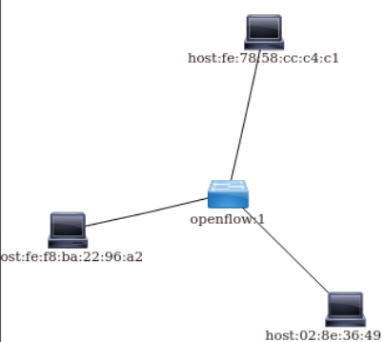
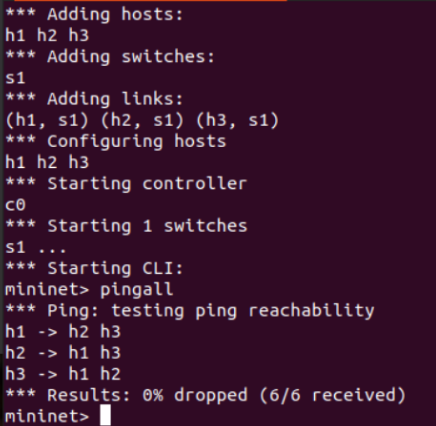
(2) 下发指令删除s1上的流表数据。
delete.py
#!/usr/bin/python
import requests
from requests.auth import HTTPBasicAuth
if __name__ == "__main__":
url = 'http://127.0.0.1:8181/restconf/config/opendaylight-inventory:nodes/node/openflow:1/'
headers = {'Content-Type': 'application/json'}
res = requests.delete(url, headers=headers, auth=HTTPBasicAuth('admin', 'admin'))
print (res.content)
(3) 下发硬超时流表,实现拓扑内主机h1和h3网络中断20s。

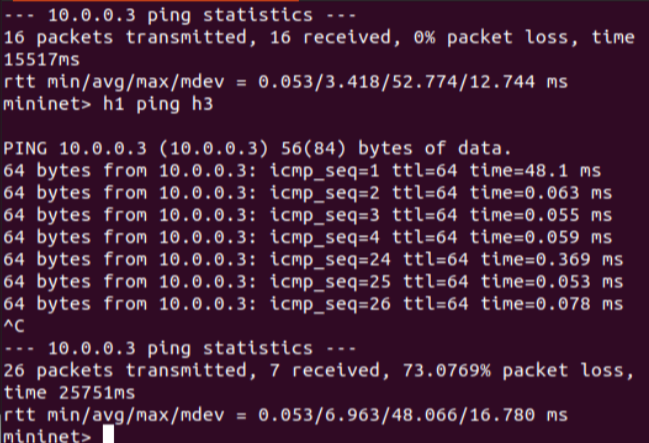
timeOut.py
#!/usr/bin/python
import requests
from requests.auth import HTTPBasicAuth
if __name__ == "__main__":
url = 'http://127.0.0.1:8181/restconf/config/opendaylight-inventory:nodes/node/openflow:1/flow-node-inventory:table/0/flow/1'
with open("./timeOut.json") as file:
str = file.read()
headers = {'Content-Type': 'application/json'}
res = requests.put(url, str, headers=headers, auth=HTTPBasicAuth('admin', 'admin'))
print (res.content)
timeOut.json
# timeout.json {
"flow": [ {
"id": "1",
"match": {
"in-port": "1",
"ethernet-match": {
"ethernet-type": {
"type": "0x0800" } },
"ipv4-destination": "10.0.0.3/32" },
"instructions": {
"instruction": [ {
"order": "0",
"apply-actions": {
"action": [ {
"order": "0",
"drop-action": {} } ] } } ] },
"flow-name": "flow",
"priority": "65535",
"hard-timeout": "20",
"cookie": "2",
"table_id": "0" } ] }
(4) 获取s1上活动的流表数。


getflow.py
# getflow.py
import requests
from requests.auth
import HTTPBasicAuth
if __name__ == "__main__":
url = 'http://127.0.0.1:8181/restconf/operational/opendaylight-inventory:nodes/node/openflow:1/flow-node-inventory:table/0/opendaylight-flow-table-statistics:flow-table-statistics'
headers = {'Content-Type': 'application/json'}
res = requests.get(url,headers=headers, auth=HTTPBasicAuth('admin', 'admin'))
print (res.content)
编写Python程序,调用Ryu的北向接口实现以下功能
(1) 实现上述OpenDaylight实验拓扑上相同的硬超时流表下发。
ryu_timeout.py
# ryu_timeout.py
import requests
if __name__ == "__main__":
url = 'http://127.0.0.1:8080/stats/flowentry/add' with open("./ryu_timeout.json") as file: str = file.read()
headers = {'Content-Type': 'application/json'}
res = requests.post(url, str, headers=headers)
print (res.content)
ryu_timeout.json
# ryu_timeout.json {
"dpid": 1, "cookie": 1,
"cookie_mask": 1,
"table_id": 0,
"hard_timeout": 20,
"priority": 65535, "flags": 1,
"match":{ "in_port":1 },
"actions":[ ] }
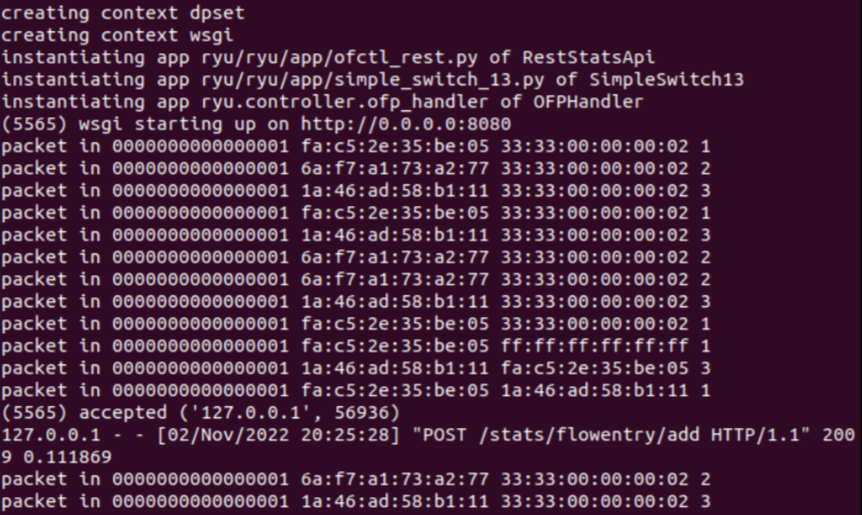

(2) 参考Ryu REST API的文档,基于VLAN实验的网络拓扑,编程实现相同的VLAN配置。
提示:拓扑生成后需连接Ryu,且Ryu应能够提供REST API服务
| VLAN_ID Hosts | |
|---|---|
| 0 | h1 h3 |
| 1 | h2 h4 |
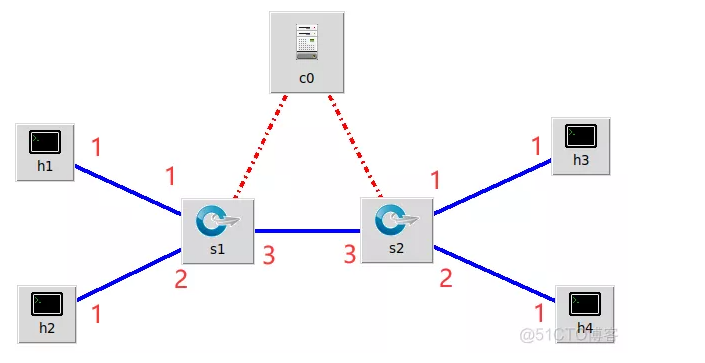
创建拓扑图
sudo mn --custom mytopo.py --topo mytopo --mac --controller=remote,ip=127.0.0.1,port=6633 --switch ovsk,protocols=OpenFlow13
topo.py
from mininet.topo import Topo
class MyTopo(Topo):
def __init__(self):
# initilaize topology Topo.__init__(self)
self.addSwitch("s1")
self.addSwitch("s2")
self.addHost("h1")
self.addHost("h2")
self.addHost("h3")
self.addHost("h4")
self.addLink("s1", "h1")
self.addLink("s1", "h2")
self.addLink("s2", "h3")
self.addLink("s2", "h4")
self.addLink("s1", "s2")
topos = {'mytopo': (lambda: MyTopo())}
ryu_vlan.py
#!/usr/bin/python
import json
import requests
if __name__ == "__main__":
url = 'http://127.0.0.1:8080/stats/flowentry/add'
headers = {'Content-Type': 'application/json'}
flow1 = {
"dpid": 1,
"priority": 1,
"match":{ "in_port": 1 },
"actions":[ {
"type": "PUSH_VLAN",
"ethertype": 33024 }, {
"type": "SET_FIELD",
"field": "vlan_vid",
"value": 4096 }, {
"type": "OUTPUT",
"port": 3 } ] }
flow2 = { "dpid": 1,
"priority": 1,
"match":{
"in_port": 2 },
"actions":[ {
"type": "PUSH_VLAN",
"ethertype": 33024 }, {
"type": "SET_FIELD",
"field": "vlan_vid",
"value": 4097 }, {
"type": "OUTPUT",
"port": 3 } ] }
flow3 = { "dpid": 1,
"priority": 1,
"match":{ "vlan_vid": 0 },
"actions":[ {
"type": "POP_VLAN",
"ethertype": 33024 }, {
"type": "OUTPUT",
"port": 1 } ] }
flow4 = { "dpid": 1,
"priority": 1,
"match": { "vlan_vid": 1 },
"actions": [ {
"type": "POP_VLAN",
"ethertype": 33024 }, {
"type": "OUTPUT",
"port": 2 } ] }
flow5 = { "dpid": 2,
"priority": 1,
"match": {"in_port": 1 },
"actions": [ {
"type":"PUSH_VLAN",
"ethertype": 33024 }, {
"type": "SET_FIELD",
"field": "vlan_vid",
"value": 4096 }, {
"type": "OUTPUT",
"port": 3 } ] } f
low6 = { "dpid": 2,
"priority": 1,
"match": { "in_port": 2 },
"actions": [ {
"type": "PUSH_VLAN",
"ethertype": 33024 }, {
"type": "SET_FIELD",
"field": "vlan_vid",
"value": 4097 }, {
"type": "OUTPUT",
"port": 3 } ] }
flow7 = { "dpid": 2,
"priority": 1, "match": {
"vlan_vid": 0 },
"actions": [ {
"type": "POP_VLAN",
"ethertype": 33024 }, {
"type": "OUTPUT",
"port": 1 } ] }
flow8 = { "dpid": 2,
"priority": 1,
"match": { "vlan_vid": 1 },
"actions": [ {
"type": "POP_VLAN",
"ethertype": 33024 }, {
"type": "OUTPUT",
"port": 2 } ] }
res1 = requests.post(url, json.dumps(flow1), headers=headers)
res2 = requests.post(url, json.dumps(flow2), headers=headers)
res3 = requests.post(url, json.dumps(flow3), headers=headers)
res4 = requests.post(url, json.dumps(flow4), headers=headers)
res5 = requests.post(url, json.dumps(flow5), headers=headers)
res6 = requests.post(url, json.dumps(flow6), headers=headers)
res7 = requests.post(url, json.dumps(flow7), headers=headers)
res8 = requests.post(url, json.dumps(flow8), headers=headers)
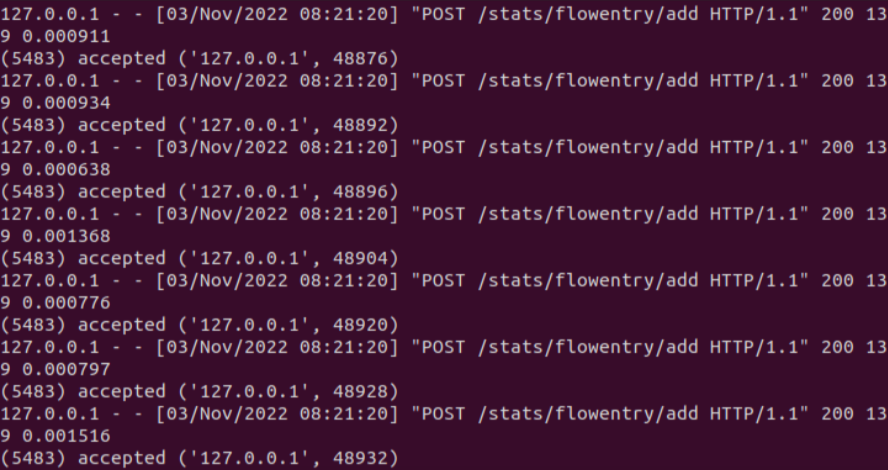





 浙公网安备 33010602011771号
浙公网安备 33010602011771号